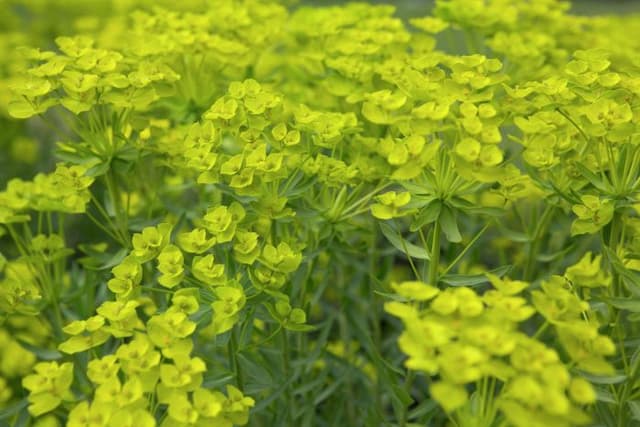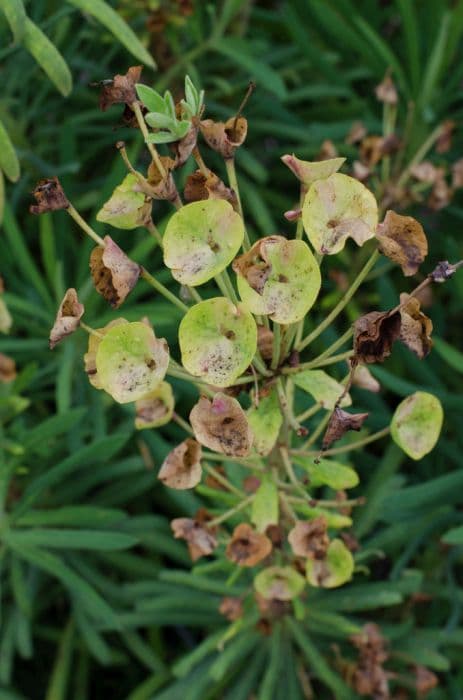Griffith's spurge Euphorbia griffithii

ABOUT
Euphorbia griffithii, commonly known as Griffith's spurge, is a striking perennial that is most noted for its vibrant and colorful attributes. It features an eye-catching array of foliage, flowers, and stems that contribute to its ornamental appeal. The leaves of Griffith's spurge display a lance-shaped structure with pointed tips, offering a rich green color that can transition into captivating orange-red tones, especially in the fall. This adds a touch of warm, seasonal color to gardens. The plant is distinguished by its unique flowering structures called cyathia, which is typical of the Euphorbia genus. Each individual cyath is comprised of tiny, inconspicuous flowers surrounded by bracts that often mimic the appearance of petals. Griffith's spurge produces flowers that are encased within colorful bracts, usually boasting shades of fiery red and orange; these hues can vary and deeply intensify as the season progresses, creating a display that's visually dynamic and scintillating. Adding more interest to the plant, the stems have a robust and upright character and may exhibit a reddish tinge that echoes the warmth of the bracts and leaves, crafting a cohesive visual statement. Furthermore, the overall presence of Griffith's spurge is known for its ability to catch the eye and hold attention in garden settings, where its rich colors and textural leaves play against other garden greenery to striking effect.
About this plant
 Names
NamesFamily
Euphorbiaceae
Synonyms
Griffith's Spurge, Fireglow
Common names
Euphorbia griffithii.
 Toxicity
ToxicityTo humans
Fireglow is poisonous to humans. The plant contains a milky sap that can cause skin irritation upon contact. If ingested, the sap can lead to severe irritation of the mouth and throat, abdominal pain, vomiting, and diarrhea. In some cases, it can also cause difficulty breathing. Contact with the eyes can result in pain and temporary blindness. It is important to handle Fireglow with care and wash hands thoroughly after coming into contact with the plant.
To pets
Fireglow is toxic to pets. The milky sap contains compounds that can irritate the skin, mouth, and digestive tract if ingested. Symptoms of poisoning in pets may include vomiting, diarrhea, drooling, pawing at the face if the sap comes into contact with their skin, and in severe cases, weakness or tremors. It is crucial to keep pets away from Fireglow and seek veterinary care immediately if they have consumed any part of the plant.
 Characteristics
CharacteristicsLife cycle
Perennials
Foliage type
Deciduous
Color of leaves
Green
Flower color
Red
Height
2-3 feet (60-90 cm)
Spread
2-3 feet (60-90 cm)
Plant type
Herb
Hardiness zones
5
Native area
Himalayas
Benefits
 General Benefits
General Benefits- Ornamental Value: Euphorbia griffithii, commonly known as Griffith's spurge, adds aesthetic appeal to gardens with its vibrant orange-red flowers and attractive foliage.
- Drought Tolerance: Griffith's spurge is resistant to dry conditions once established, making it suitable for drought-prone areas and water-wise gardens.
- Low Maintenance: This plant requires minimal care once established, with no need for regular watering or fertilizing, making it ideal for gardeners looking for low-maintenance options.
- Pest Resistance: It is generally free from major pest problems, reducing the need for chemical treatments and contributing to a healthier garden ecosystem.
- Seasonal Interest: Its distinctive spring and summer blooms, as well as colorful autumn foliage, provide multi-seasonal interest in the landscape.
- Landscape Versatility: Can be used in a variety of garden settings, from borders to rock gardens, and as a ground cover.
- Pollinator Attraction: The flowers can attract beneficial insects such as butterflies and bees, supporting local pollinator populations.
- Erosion Control: The robust root system of Griffith's spurge can help stabilize soil and prevent erosion on slopes.
- Diversity addition: Adding Euphorbia griffithii to a garden increases plant diversity, which can enhance overall ecosystem health and resilience.
 Medical Properties
Medical PropertiesThis plant is not used for medical purposes.
 Air-purifying Qualities
Air-purifying QualitiesThis plant is not specifically known for air purifying qualities.
 Other Uses
Other Uses- Euphorbia griffithii, commonly known as Griffith's spurge, can be used to create vibrant natural dyes for textiles, with the stems and leaves producing a range of fiery orange to reddish-brown hues, depending on the mordant used.
- In certain cultures, the sap of Griffith's spurge has been used as a traditional fish poison, where it is introduced into small bodies of water to stun or kill fish for easy collection.
- The architectural form and color of Griffith's spurge make it a valuable addition for floral arrangements, providing both height and dramatic color contrast when used as a cut flower.
- Griffith's spurge plants can be incorporated into permaculture designs as a living barrier that can protect more delicate plants from wind or as a hedge due to their dense growth.
- Gardeners may employ the plant's vigorous nature for soil stabilization purposes, particularly in areas prone to erosion or on sloping ground.
- The unique appearance of Griffith's spurge can be used in the art of bonsai, where its colorful appearance can create a striking miniature landscape feature.
- The plant has potential use in educational settings, as it serves as an example of co-evolution with its specific pollinators and the deployment of its toxic sap as a defense mechanism.
- Its drought-resistant qualities make Griffith's spurge a suitable candidate for xeriscaping, a landscaping method that reduces or eliminates the need for supplemental water from irrigation.
- The plant can be used in butterfly gardens as it attracts and provides a food source for certain species of butterflies and other beneficial insects that feed on the nectar.
- In craft applications, the dried seed pods of Griffith's spurge may be utilized for decorative purposes in wreaths and dried floral displays, adding both texture and color.
Interesting Facts
 Feng Shui
Feng ShuiThe plant Euphorbia griffithii, commonly known as Fireglow, is not used in Feng Shui practice.
 Zodiac Sign Compitability
Zodiac Sign CompitabilityFireglow is not used in astrology practice.
 Plant Symbolism
Plant Symbolism- Resilience: Euphorbia griffithii, commonly known as Griffith's spurge, often symbolizes resilience due to its hardy nature and ability to thrive in challenging environments.
- Determination: The plant's vigorous growth and assertive spread can represent determination, highlighting a persistent drive to overcome obstacles.
- Protection: The sap of Griffith's spurge is toxic and can be irritating, which may symbolize protection or defense against threats and negativity.
- Transformation: With its bright fiery-red flowers, Griffith's spurge is sometimes associated with transformation and change, reflecting its vibrant and dynamic appearance that evolves through the seasons.
 Water
WaterFireglow Spurge should be watered deeply once a week during the growing season and more sparingly in winter, when the plant is dormant. In the heat of the summer, it may require watering twice a week if the soil dries out completely. Generally, provide about half a gallon of water per plant for each watering session, ensuring that the water penetrates deeply into the soil to encourage strong root development. Reduce the frequency of watering in fall as the plant prepares for dormancy. Overwatering can lead to root rot, so it's important to allow the soil to dry out slightly between waterings.
 Light
LightFireglow Spurge thrives in full sun to partial shade. For optimal growth, place it in a location where it can receive at least six hours of direct sunlight each day. In regions with very hot summers, providing afternoon shade can help protect the plant from excessive heat. Avoid deep shade, as this can lead to leggy growth and fewer flowers.
 Temperature
TemperatureFireglow Spurge is hardy and can tolerate a range of temperatures but prefers conditions between 60 and 75 degrees Fahrenheit. It can survive brief periods of colder weather down to about 0 degrees Fahrenheit, but frost can damage the foliage. In summer, the plant can handle temperatures up to 90 degrees Fahrenheit without stress.
 Pruning
PruningFireglow Spurge should be pruned to remove spent flowers and maintain its shape. The best time to prune is after the main flowering period is over, usually in the late summer or early fall. Cut back the flower stems to just above a set of leaves. Pruning is also essential to remove any damaged or diseased stems to maintain plant health and vigor.
 Cleaning
CleaningAs needed
 Soil
SoilFor Fireglow, a well-draining soil mix with organic matter is ideal. Incorporate peat, perlite, and compost to promote drainage and fertility. The preferred soil pH for Euphorbia griffithii 'Fireglow' is neutral to slightly acidic, ranging from pH 6.0 to 7.0.
 Repotting
RepottingFireglow should be repotted every 2 to 3 years to refresh the soil. This will also give the opportunity to divide the plant if it has grown too large. Ensure the new pot has adequate drainage.
 Humidity & Misting
Humidity & MistingFireglow thrives in moderate humidity levels. Average room humidity is usually adequate, avoiding extremes of very dry or excessively humid conditions for optimal growth.
 Suitable locations
Suitable locationsIndoor
Place Fireglow in bright, indirect light indoors.
Outdoor
Plant Fireglow in a sunny spot with partial shade.
Hardiness zone
5-9 USDA
 Life cycle
Life cycleEuphorbia griffithii, known as Griffith's spurge, starts its life as a seed that germinates in spring when soil temperatures warm up. Seedlings establish themselves with a taproot and begin to grow a rosette of leaves. As the plant matures, typically within the first year, it develops a sturdy stem and a more pronounced root system, with the characteristic foliage becoming denser. During late spring to early summer, Griffith's spurge produces vibrant flower bracts that are often fiery orange-red, surrounding the actual tiny flowers. After pollination, which is often facilitated by insects, the plant sets seed in the form of three-lobed capsules that eventually dry and burst open to disperse seeds. The plant is a perennial and will die back to the ground in winter in colder climates, re-emerging from the root system in the following spring.
 Propogation
PropogationPropogation time
Spring-Early Summer
The most popular method of propagating Fireglow Spurge (Euphorbia griffithii) is through division. This is best done in the spring as new growth becomes apparent. To propagate by division, carefully dig up the clump of the plant, ensuring a good amount of the root system is intact. Using a sharp spade or knife, divide the clump into smaller sections, each with at least one growth bud. Replant the new divisions promptly, spacing them about 15 to 18 inches (38 to 46 centimeters) apart. Water the divisions well after planting to help establish them. This vegetative approach is especially effective because it maintains the characteristics of the parent plant.









